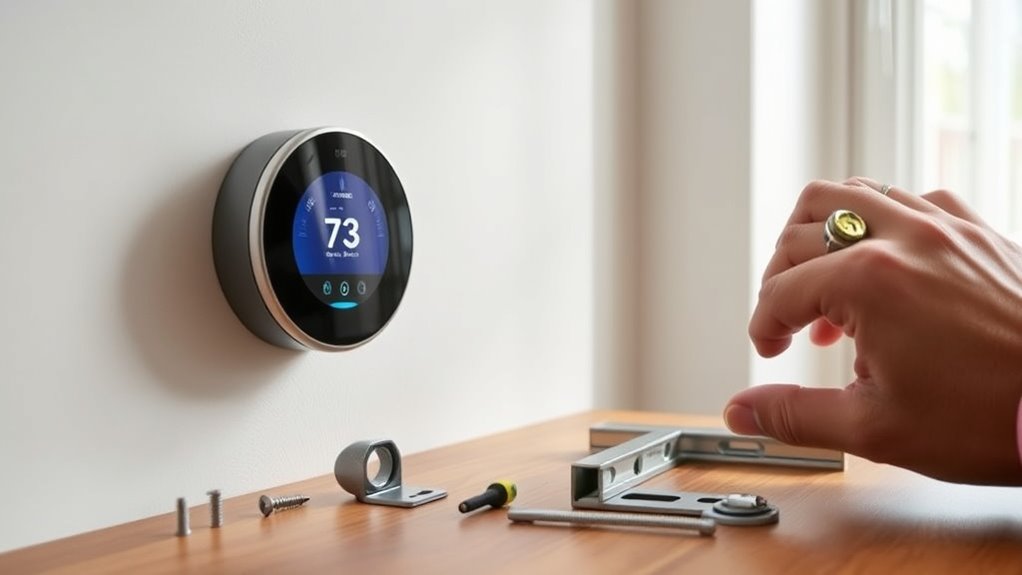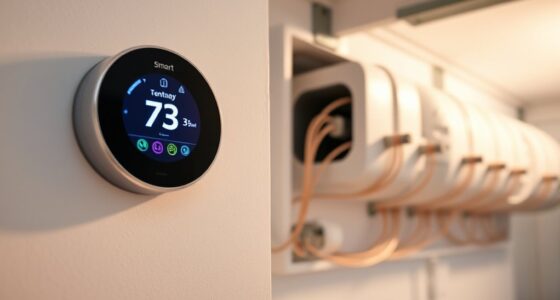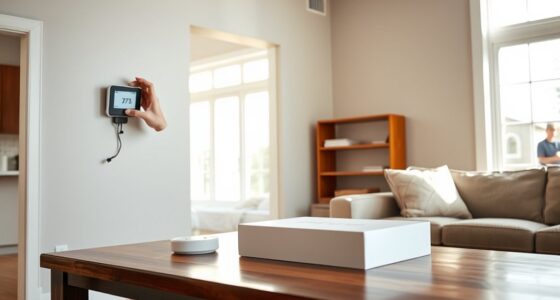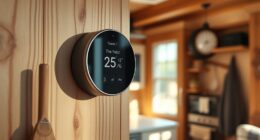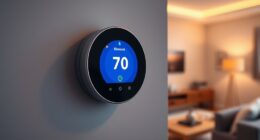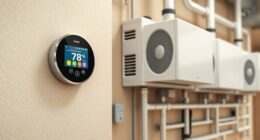To install smart thermostats in your apartment, start by checking compatibility with your existing HVAC system and informing your tenants about the upgrade. You can often do a DIY install with basic wiring knowledge or hire a professional for a smooth process. Be sure to provide clear instructions and communicate the benefits to tenants. For more detailed steps on making this process smooth and landlord-friendly, keep exploring how you can effectively manage this upgrade.
Key Takeaways
- Verify thermostat compatibility with existing wiring and HVAC systems before installation.
- Obtain necessary permissions or notify tenants in advance about the upgrade process.
- Consider professional installation to ensure proper setup and compliance with electrical standards.
- Communicate benefits and usage instructions clearly to tenants to encourage acceptance and engagement.
- Use energy reports from the smart thermostat to monitor savings and optimize property management.
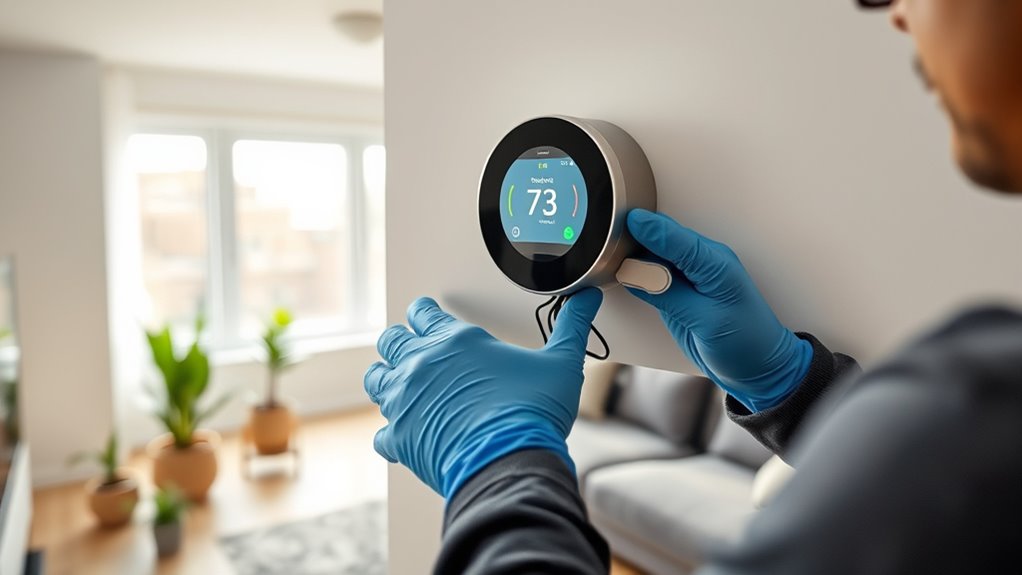
Installing a smart thermostat in your apartment is a straightforward way to boost comfort and save energy. As a landlord, this upgrade can lead to significant benefits, including reduced utility costs and happier tenants. When you install a smart thermostat, you’re giving your tenants the ability to control their indoor environment more effectively, which directly enhances tenant comfort. With features like programmable schedules and remote access, tenants can set their preferred temperatures and make adjustments without hassle, ensuring they stay comfortable throughout the day and night. This increased control often results in fewer complaints about temperature issues, improving tenant satisfaction and retention.
From an operational perspective, smart thermostats promote energy savings by optimizing heating and cooling cycles. They learn occupancy patterns and adjust settings accordingly, avoiding unnecessary energy consumption when apartments are empty or during unoccupied hours. This intelligent management means you could see lower utility bills, which benefits both you and your tenants. Plus, many smart thermostats come with energy usage reports, enabling you to monitor consumption patterns and identify opportunities for further savings. This data-driven approach allows you to make informed decisions about your property’s energy management, aligning comfort with efficiency. Additionally, the ability to integrate with other smart home devices can further enhance energy control and convenience. It’s also beneficial to consider the compatibility of the smart thermostat with your existing heating and cooling systems to ensure a smooth upgrade.
Smart thermostats learn occupancy patterns to optimize energy use and reduce utility costs for landlords and tenants.
When it comes to installation, keeping the process landlord-friendly is key. First, ensure that the existing thermostats are compatible with the smart models you plan to install. Most smart thermostats are designed to work with standard wiring, making installation relatively simple and quick. You can handle the setup yourself if you’re comfortable with basic wiring, or hire a professional for a seamless, hassle-free process. Communicate clearly with your tenants about the installation schedule, emphasizing minimal disruption and the long-term benefits. It’s also wise to review your lease agreement to confirm any necessary permissions or notices required before making such upgrades.
To make the changeover smooth, provide tenants with straightforward instructions on how to use the new thermostat features. Highlight the convenience of remote control and scheduled settings to encourage regular use. This not only maximizes energy savings but also ensures tenants experience the full benefit of improved comfort. Additionally, offering a brief demonstration or written guide can help tenants feel more confident in managing their new device. Remember, keeping tenants informed and involved in the upgrade process fosters trust and demonstrates your commitment to their comfort. Incorporating smart technology can also further streamline energy management and enhance tenant satisfaction.
Frequently Asked Questions
Can Tenants Install Smart Thermostats Without Landlord Approval?
You might wonder if you can install a smart thermostat without landlord approval. Generally, DIY modifications like this can be tricky because tenant rights often don’t cover permanent changes. It’s best to check your lease and talk to your landlord first. If approved, guarantee the installation is reversible to avoid disputes. Respecting the rules helps maintain a good relationship and keeps your tenant rights protected.
What Are the Legal Implications of Installing a Smart Thermostat?
Installing a smart thermostat is like opening a window to new tech possibilities, but it comes with legal considerations. You might face privacy concerns, as these devices collect data on your habits. Plus, improper installation could affect energy efficiency and your lease agreement. Always review local laws and your lease to avoid disputes, and consider informing your landlord to stay compliant and protect your rights.
How Does Smart Thermostat Installation Affect Security Deposits?
Installing a smart thermostat can impact your security deposit, as landlords may deduct costs for damage or necessary repairs, considering tenant liability. If you install it properly, with landlord approval, you reduce the risk of deductions. However, if removal causes damage or leaves the system in disrepair, your security deposit might be affected. Always follow lease terms and document the process to protect your deposit from unnecessary deductions.
Are There Any Specific Apartment Codes for Thermostat Upgrades?
Think of building codes as the unseen conductors guiding your upgrade symphony. When installing a smart thermostat, you’ll need to follow specific building codes and permit requirements that guarantee safety and compliance. These rules act like a map, guiding you through the legal landscape. Always check local regulations before proceeding, so your thermostat upgrade harmonizes perfectly with the apartment’s infrastructure, avoiding dissonant fines or delays.
Who Is Responsible for Maintaining Smart Thermostats in Rentals?
You’re responsible for maintaining smart thermostats in rentals, but first, verify they’re compatible with your heating system. You should also follow the landlord consent process before installation, as this helps avoid misunderstandings. Regularly check the thermostat’s functionality and update the software if needed. If issues arise, report them promptly to your landlord to keep everything running smoothly, ensuring the system remains efficient and effective.
Conclusion
Installing a smart thermostat in your apartment is a straightforward way to boost comfort and save energy, all while respecting your landlord’s rules. Just follow these steps, communicate clearly, and keep everything above board. Remember, this isn’t the age of the Tower of Babel—clear cooperation makes the process smooth. Once installed, you’ll enjoy modern convenience like it’s the dawn of a new era. Welcome to smarter living, my friend—your cozy, energy-efficient future awaits!
